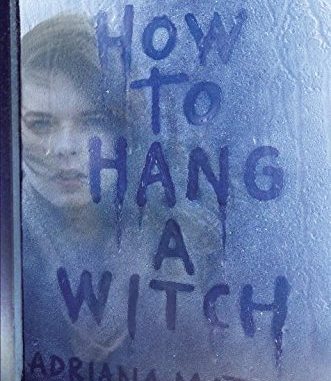
 As part of our ongoing collaboration with the Book House of Stuyvesant Plaza, our writers have accepted the challenge of reading and reviewing pre-publication review copies of highly anticipated young adult literature. The reviews are posted here for our readers, but also will be sent to the Book House where they will hopefully be used to inform customers about the books they may want to purchase.We will try to publish one review a week for the spring.
As part of our ongoing collaboration with the Book House of Stuyvesant Plaza, our writers have accepted the challenge of reading and reviewing pre-publication review copies of highly anticipated young adult literature. The reviews are posted here for our readers, but also will be sent to the Book House where they will hopefully be used to inform customers about the books they may want to purchase.We will try to publish one review a week for the spring.
The reviews contain spoilers, so be forewarned!
How to Hang a Witch
by Adriana Mather
Published July 2016
368 pages, Knopf Books for Young Readers
Have you ever felt alone? Been bullied by a group of mean girls? Found yourself in a constant storm of bad luck–almost as if you’re cursed? If so, then you can definitely relate to the struggle of Samantha Mather, a normal high school student who just transferred to Salem, Massachusetts. Of course, she is also a direct descendant of one of the men responsible for the Salem Witch Trials. Her story is told by Adriana Mather in How to Hang a Witch, a captivating novel that ties historical fiction into magical realism, a twist that keeps the reader at the edge of his or her seat.
Sam Mathers is having a rough time in high school, a struggle that most young adults can relate to. But her circumstance is a little unique. Her friends never seem to stick around, her father is in a coma, and now her step-mother, Vivian, is making her move to a new school far away from her home and, tragically, her father. She is sick of all this bad luck. However, when a certain tall, blonde, and handsome boy named Jaxon enters her life, things begin to turn around. That is, until she finds out her house is haunted by Elijah, the not-so-friendly ghost. School doesn’t seem to be an escape from her home considering it is ruled by the “Descendants,” a group of teenagers who are obsessed with heritage and unluckily for Sam, she’s on the wrong side of the trial. So what could get worse? Oh, that’s right–Sam and her family are cursed! Though, this seems to be Sam’s key in “befriending” the Descendants and before she knows it they are on the hunt to figure out how this curse originated. This newfound–and confusing!–relationship between the Descendents and Sam is throwing everyone for a loop, including Jaxon. Their blooming relationship becomes strained as the secrets pile up and the tension within the town grows. Facades begin to drop and Sam gets the shock of her life when she figures out that Ann, Elijah’s ex-fiance, was a witch. A witch that disguised herself as Sam’s step-mother for years just for the chance to use Sam, the only living Mather who can see spirits, to bring Elijah back to life. Sam manages to escape Vivian with the help of not only Elijah and the Descendents, but the infamous Cotton Mather. Together, the witch of Salem is defeated and the novel comes to a satisfactory resolution: Vivian becomes a rejuvenated and peaceful spirit, Elijah leaves Sam to be with his sister, Abigail, Sam finally accepts the relationship between her and Jaxon, and Salem is free of its curse.
As is often seen in Young Adult (YA) literature, this novel encompasses a very cliche theme: mean girls. The stereotypical high school experience is evident within the first 20 pages when the reader is introduced to Sam, the female lead; Jaxon, the popular boy who winds up in a relationship with the female lead; Alice, the head mean girl; Lizzie and Mary, the head mean girl’s side kicks who are secretly willing to be friends with the female lead; and John and Susannah, static friends who remain cold to the female lead throughout the novel. Just like in the movie, Mean Girls, the Descendents have a strict “you-can’t-sit-with-us” policy and shun Sam from the beginning. Despite Sam’s attempts to remove herself from the toxic situation and to make peace, like when she brought them pastries, she is relentlessly terrorized. However, Sam overcomes this conflict when she must work together with the Descendents to search for the truth of the deadly curse; it turns out, Sam isn’t the only one with bad luck–it affects all of the families that have ties to the original Salem Witch Trials. Sam has figured out, “[The] deaths aren’t random. They occur in a pattern. And they’re triggered when one member of each of the major Witch Trials’ families is in Salem. Unfortunately, there’s a complete list of major families here right now” (134-35). Even though this affects so many, as the descendent of Cotton Mather, an infamous figure head of the trials, Sam has a big “X” painted on her back and the rest of the town knows it. A few mean girls are child’s play when a whole town wants you gone.
A second prominent theme in the novel is Sam’s fear of leaving and of being left behind. This fear is caused by the curse, which seems to treat Sam the worst by far. Her friends from New York never stayed around very long because of her bad luck. Then, her father winds up comatose in a hospital in New York and she is forced to leave him when Vivian makes her move to Salem, Massachusetts. The first the reader sees of Sam is when she arrives in Salem and she is cold, uncaring until Jaxon gets a rise out of her. After their first encounter, she says, “He disappears down the wooden hall lit by small lamps, and for the first time since my dad got sick, I actually feel like myself” (8). This budding romance draws her out of the shell she has created in an attempt to protect herself from getting attached again because she is scared of the vulnerability that comes with being left behind. Once Elijah comes into the picture, the reader can once again observe her default to protect herself from abandonment. The love triangle is yet another cliche aspect of this book, but it serves to advance this theme because Sam has romantic options, and who she chooses says more about her than either of the boys. First, chooses Elijah. Because Elijah is a ghost, he is here to stay and he can be anywhere at anytime with no prior commitments. He is always available and he will never leave. She is subconsciously protecting herself once again. However, at the resolution of the novel, they kiss and it is finally the time to decide if advancing their relationship is worth a try. But, he becomes an integral part in her ability to move on from this fear:
“You must live your life, Samantha,” he says, but holds me, still.
Dread slithers into the warm space of our touching bodies. My words fight me on their way out. “You can’t leave.”
“I think it would be better for you if I did.”
My heart Ping-Pongs in my chest like a caged bird. I shake my head, unsure how to keep myself from drowning us both in my emotions. “I don’t want to do this without you.”
“You’ve already done it.” (345)
Immediately after this exchange, Jaxon arrives at the scene. Elijah truly helps Sam move on by sacrificing their chances at a romantic relationship to give her one with Jaxon. So far, Jaxon and Sam’s relationship has been characterized throughout the novel by his insistence to remain by her side no matter what she does. The exact moment that Sam has this epiphany is the moment she sees Jaxon after Elijah leaves. She thinks, “He came to help me after everything I did to him?” and she commits herself to him and only him, allowing herself to show vulnerability (345). She finally overcomes the fear that has inhibited her from the beginning of the novel.
The themes of “mean girls” and a fear of being left behind are prevalent throughout every aspect of How to Hang a Witch. Although the themes are cliche and often overused in YA literature, Mather recognizes that YA readers often connect with them strongly and she uses that to teach the reader a somewhat convoluted history in an engaging story. Mather provides the reader with a full and comprehensive understanding of the impact of history by the end of the novel. In conclusion, this novel is successful because it serves not only to entertain, but also to teach.
